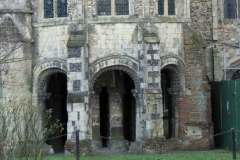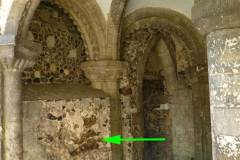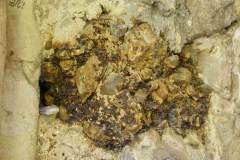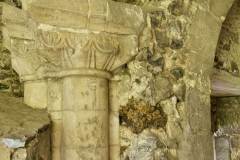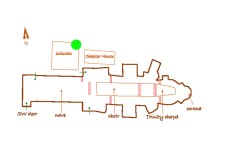Basics
Geology: Iron-cemented river gravel
Rock Unit: Drift Deposit (river gravel)
Age: Holocene
Provenance: Stour Valley, Kent
Where to see examples:
The churches at Westbere and Sturry have both used this stone in their east ends and the cloistral buildings of St. Augustine’s monastery still retain several walls containing ferricrete. At Canterbury Cathedral it can best be seen as individual concretions at ground level in Prior Wibert’s Water Tower, whilst at higher levels on the walls of the north-east transept it has been used more extensively.
on the water tower (images 1-3 further below)
isolated stones in the main cloisters (images 4 and 5 further below)
Description
Ferricrete is a name used by some geologists to describe coarse sandstones and gravels that are cemented by iron. The material in the cathedral walls can be described as a coarse gravel bound in a rusty-brown, iron-rich cement. In some local texts the stone has been referred to as a ‘pudding stone’ i.e. rounded pebbles in a fine matrix. Some geologists prefer to use the term ‘iron cemented gravel’ to describe the material. The ferricrete used in the cathedral is a local stone from the valley of the River Stour, where extensive gravel deposits are today quarried for aggregate (although these are not cemented by iron). The specific site or sites of medieval quarrying are not known and . The river gravels of the Stour are composed of loose, irregular-shaped and rounded pebbles of flint that are often iron-stained.
To form ferricrete rain water has first percolated through the ground and leached iron from the soil and overlying sediments. The iron-rich waters have then infiltrated gravels lying below. Here, local conditions were conducive for the iron to be precipitated out of solution to form a hard ‘crust’ around the individual flints bonding them together. The iron-encrusted gravel has hardened (de-watered) to form a new, cohesive and durable rock.
Pieces of ferricrete are invariably irregular in shape and contain numerous flint nodules. They were probably broken down into these sizes from a larger concretion for ease of transportation at the site of quarrying. Their utility as a building stone is because the flint nodules came ‘ready-cemented’, however, they are far from a decorative material and together with their irregular shape means they are used only for rubble wall construction.

